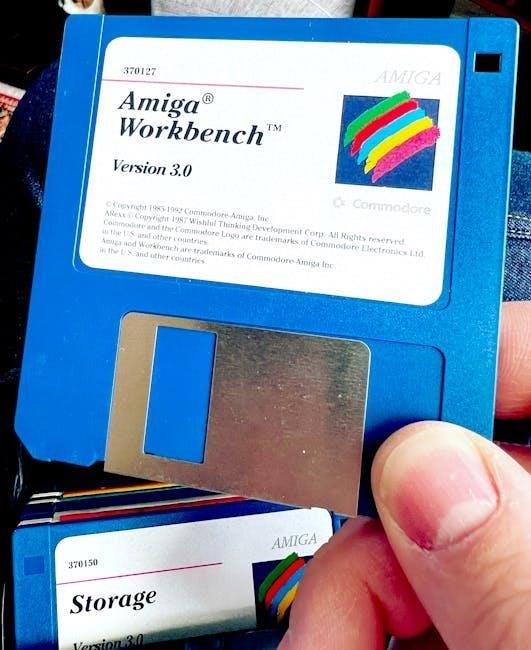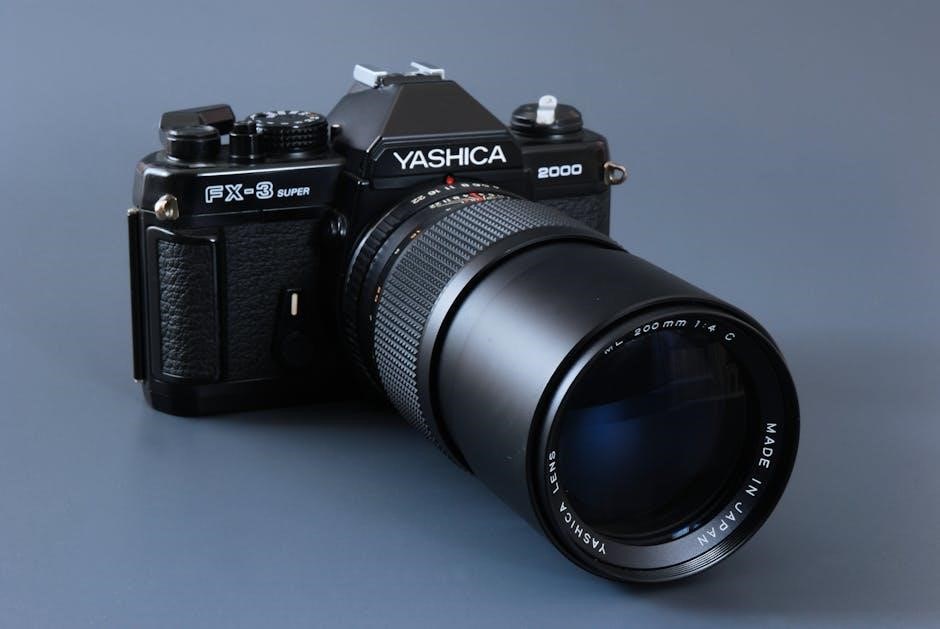The Econolite ASC/3 Controller is a advanced traffic signal controller designed to optimize traffic flow and safety. It integrates with smart traffic systems for efficient management.
1.1 Overview of the ASC/3 Controller
The Econolite ASC/3 Controller is a sophisticated traffic signal control system designed to manage and optimize traffic flow efficiently. It offers advanced features for real-time monitoring, adaptive signal control, and integration with intelligent transportation systems (ITS). The controller is built to handle complex traffic scenarios, ensuring safety and reducing congestion. Its modular design allows for easy customization and scalability, making it suitable for various urban and suburban environments. The ASC/3 is widely used by traffic engineers and city planners to implement coordinated signal timing plans and respond to dynamic traffic conditions. Its user-friendly interface and robust functionality make it a cornerstone of modern traffic management systems.
1.2 Importance of the ASC/3 in Traffic Management
The ASC/3 Controller plays a pivotal role in modern traffic management by enhancing efficiency and safety. Its ability to adapt to real-time traffic conditions ensures optimal signal timing, reducing congestion and lowering travel times. The system supports coordinated signal plans across multiple intersections, improving overall network performance. Additionally, the ASC/3’s integration with ITS enables data-driven decision-making, allowing traffic engineers to respond swiftly to incidents. Its reliability and scalability make it a critical asset for urban mobility, contributing to smoother traffic flow and reduced environmental impact through decreased vehicle emissions. The ASC/3 is essential for creating intelligent transportation systems that meet the demands of growing urban populations.

Installation and Setup of the ASC/3 Controller
Installation involves hardware setup, software installation, and initial configuration. Ensure compatibility with existing systems and follow manufacturer guidelines for a seamless setup process.

2.1 Hardware Installation Requirements
The ASC/3 Controller requires specific hardware to ensure optimal performance. Compatibility with existing traffic systems is crucial. Ensure the controller is installed in a secure, climate-controlled environment. Proper power supply and grounding are essential to prevent damage. Verify that all necessary ports and interfaces are available for detector connections. Mount the controller in a rack or cabinet to maintain organization and accessibility. Follow Econolite’s guidelines for wiring and connections to avoid malfunctions. Ensure the hardware meets the specified voltage and power requirements. Additionally, check for any firmware updates before initializing the system. Proper installation ensures reliable operation and integrates seamlessly with traffic management software.
2.2 Software Setup and Compatibility
The ASC/3 Controller requires compatible software for programming and operation. Ensure the system runs on a supported operating system, such as Windows 10 or Linux. Install the latest version of the ASC/3 GUI to access advanced features. Verify that the software is compatible with the controller’s firmware. Follow the installation wizard for a seamless setup process. Regularly update the software to maintain functionality and security. Compatibility with third-party tools, such as traffic management platforms, is essential for integrated operations. Always refer to Econolite’s documentation for specific software requirements. Proper software setup ensures efficient programming and reliable performance of the controller in traffic management systems.
2.3 Initial Configuration Steps
Begin by connecting the ASC/3 Controller to a computer via a communication cable or network. Power on the controller and ensure all hardware components are recognized. Open the ASC/3 GUI software and select the appropriate controller from the device list. Set the IP address and communication parameters to establish a connection. Configure basic settings, such as timing plans and detector inputs, using the GUI interface. Review the default parameters and adjust them according to local traffic requirements. Save the configuration to ensure settings are retained. Finally, test the system to verify proper operation. Follow Econolite’s documentation for detailed step-by-step guidance to complete the initial setup successfully.

Programming the ASC/3 Controller
Programming the ASC/3 Controller involves creating timing plans and configuring detector settings using the GUI. It ensures efficient traffic management through customizable parameters and real-time adjustments.
3.1 Programming Overview and Basics
Programming the ASC/3 Controller begins with understanding its core functions. It involves creating and editing timing plans, configuring detector settings, and using the GUI for intuitive control. The process ensures traffic signals operate efficiently, adapting to real-time conditions. Basic steps include defining signal phases, setting phase durations, and enabling detector inputs. The GUI simplifies these tasks, allowing users to visualize and adjust parameters easily. Proper programming ensures smooth traffic flow, reduces congestion, and enhances safety. Familiarity with the controller’s software and hardware is essential for effective programming. Regular updates and adjustments are necessary to maintain optimal performance and adapt to changing traffic demands.
3.2 Using the ASC/3 GUI for Programming
The ASC/3 GUI provides a user-friendly interface for programming traffic signal controllers. It allows users to input data, monitor real-time traffic conditions, and adjust settings seamlessly. The GUI supports advanced search features, enabling quick access to specific functions. Users can customize traffic plans, configure detectors, and troubleshoot issues efficiently. The interface is designed to simplify complex tasks, ensuring accurate and efficient programming. Regular updates enhance functionality, providing improved tools for traffic management. The GUI also offers drag-and-drop capabilities and built-in validation to prevent errors. This makes it an essential tool for optimizing traffic flow and ensuring safe, efficient signal operation.
3.3 Creating and Editing Timing Plans

Creating and editing timing plans with the ASC/3 Controller involves defining cycle lengths, phase sequences, and split times; Use the GUI to import existing plans or create new ones from scratch. Real-time editing allows adjustments based on traffic data. Conflict checks ensure timing consistency. Integrate with traffic sensors for dynamic updates. Export plans for deployment or further analysis. Regular updates enhance functionality, improving accuracy and efficiency. This process ensures optimal traffic flow and safety, leveraging advanced tools for precise control.
3.4 Configuring Detector Settings
Configuring detector settings on the ASC/3 Controller ensures accurate traffic monitoring and responsive signal control. Start by selecting the detector type, such as inductive loops or video cameras, and integrate them into the system. Calibrate each detector for sensitivity and range to ensure reliable data collection. Use the GUI to assign detectors to specific phases and adjust timing plans based on real-time input. Test the configuration under various traffic conditions to verify accuracy. Regular updates and maintenance are crucial to maintain optimal performance and adapt to changing traffic patterns. Properly configured detectors enhance traffic flow efficiency and safety;

Advanced Configuration and Settings
Advanced configuration involves customizing controller parameters and implementing specialized traffic management features to optimize signal control for complex scenarios, ensuring efficient and adaptive traffic flow management systems.
4.1 Customizing Controller Parameters
Customizing controller parameters on the Econolite ASC/3 allows for tailored traffic management solutions. Users can adjust settings such as signal timing, phase sequences, and detector sensitivity to optimize traffic flow. The ASC/3 GUI provides an intuitive interface for modifying these parameters, ensuring precise control over traffic signal operations. Advanced features enable real-time adjustments, allowing engineers to respond to dynamic traffic conditions. Parameter customization also supports integration with smart traffic systems, enhancing overall network efficiency. By fine-tuning these settings, traffic managers can improve intersection performance, reduce congestion, and ensure safer pedestrian and vehicular movements. Regular updates and backups of customized parameters are recommended to maintain optimal functionality and adaptability.
4.2 Implementing Special Traffic Management Features
The Econolite ASC/3 Controller supports advanced traffic management features such as pedestrian priority, transit signal priority, and dynamic signal timing. These features enhance traffic flow efficiency and safety. Implementing special traffic management involves configuring settings through the ASC/3 GUI, allowing users to define custom rules for signal operation. For example, pedestrian priority can be activated during off-peak hours, while transit signal priority ensures public transportation runs smoothly. Real-time data integration enables adaptive signal control, adjusting timings based on current traffic conditions. These features are essential for modern traffic systems, providing flexibility and responsiveness to varying demands. Proper configuration ensures seamless integration with existing infrastructure, optimizing overall traffic network performance.

Maintenance and Troubleshooting
Regular maintenance ensures optimal performance of the ASC/3 Controller. Inspect hardware, update software, and use diagnostic tools to identify and resolve issues promptly for reliable operation.

5.1 Regular Maintenance Tasks
Regular maintenance is crucial for ensuring the longevity and optimal performance of the Econolite ASC/3 Controller. This includes inspecting hardware components, such as detectors and communication modules, for damage or wear. Software updates should be performed periodically to ensure compatibility and security. Additionally, checking all cable connections and ensuring proper power supply are essential. Routine diagnostics can help identify potential issues before they escalate. Maintenance tasks also involve reviewing event logs and clearing outdated data. It is recommended to follow the manufacturer’s guidelines for scheduling and executing these tasks. Proper documentation of maintenance activities is also important for tracking and future reference.
5.2 Diagnosing and Resolving Common Issues

Diagnosing and resolving common issues with the Econolite ASC/3 Controller requires a systematic approach. Start by identifying error messages or unusual behavior. Check the event logs for detailed information about system faults. Common issues include communication errors, detector malfunctions, or software glitches. For communication problems, verify cable connections and ensure proper network configuration. Detector issues may require recalibration or physical inspection. Software-related problems can often be resolved by restarting the controller or installing updates. If issues persist, consult the troubleshooting guide or contact Econolite support. Regular backups and updates can help prevent recurring problems. Always follow safety protocols when performing diagnostics or repairs.
6.1 Summary of Key Concepts
The Econolite ASC/3 Controller is a sophisticated traffic management solution offering advanced programming and configuration options. Key concepts include its modular design, intuitive ASC/3 GUI, and real-time data processing capabilities. The controller supports customizable timing plans, detector settings, and integrates seamlessly with modern traffic systems. Regular maintenance and troubleshooting are essential for optimal performance. By mastering these elements, engineers can efficiently manage traffic flow, ensuring safety and efficiency. This manual provides comprehensive guidance, enabling users to fully leverage the controller’s potential for effective traffic control and smart city applications.

6.2 Best Practices for Future Use
For optimal use of the Econolite ASC/3 Controller, regular software updates and hardware maintenance are crucial. Always backup configurations before making changes. Invest in training to ensure proficiency in programming and troubleshooting. Monitor system performance regularly to identify and address potential issues early. Collaborate with traffic experts to refine timing plans and detector settings. Document all modifications for future reference. Utilize Econolite’s technical support and resources to stay updated on best practices. By following these guidelines, users can maximize the controller’s efficiency and adaptability, ensuring long-term reliability and effectiveness in traffic management.



































































